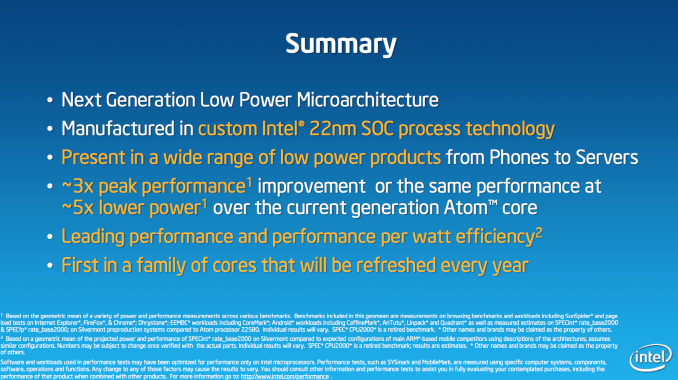Intel’s Silvermont Architecture Revealed: Getting Serious About Mobile
by Anand Lal Shimpi on May 6, 2013 1:00 PM EST- Posted in
- CPUs
- Intel
- Silvermont
- SoCs
Final Words
Silvermont really is Intel’s Conroe for the mobile market, but not in the sense that many have been expecting. Given that success in mobile is so closely tied to device wins, Silvermont alone isn’t enough. Unlike Conroe, a very competitive Silvermont won’t change the world overnight. What Silvermont does however is offer a great foundation for Intel going forward. Conroe lead to Penryn, Nehalem, Westmere, Sandy Bridge, Ivy Bridge and soon, Haswell. It was the platform that Intel could build on regularly by executing on tick-tock. Conroe paved the way for the insane advantage Intel has held onto for the past few years. Silvermont is like Conroe in that it provides that same foundation.
The mobile market is far more competitive than the PC industry was back when Conroe hit. There isn’t just one AMD but many competitors in the SoC space that are already very lean and fast moving. There’s also the fact that Intel doesn’t have tremendous marketshare in ultra mobile. Silvermont may feel a lot like Conroe, but the market it’s competing in is very different. That’s not to say that Intel can’t be successful here; it’s just not going to be easy.
Architecturally Silvermont is very conservative, and that’s not a bad thing. A side effect of not wanting to make Haswell irrelevant by a far lower cost part is the benefit of maintaining power efficiency. Intel joins the ranks of Apple and Qualcomm in intelligently scaling performance while respecting power consumption. Intel’s 22nm process should give Silvermont a lot of runway to use. If it can quickly follow up with 14nm, Silvermont’s power advantage could end up being akin to Conroe’s performance advantage in the mid-2000s.
Even so, Silvermont is long overdue. It’s the first mobile architecture where Intel really prioritized smartphones and tablets, and on paper, it looks very good. Now it’s up to Intel to turn a great architecture into great design wins. From what I’m hearing, we may actually see that happen.











174 Comments
View All Comments
extide - Wednesday, May 8, 2013 - link
What does Tegra 4 do 1.9Ghz in?Wilco1 - Wednesday, May 8, 2013 - link
Rumour is that it goes in the next ZTE phone out in a few months.phoenix_rizzen - Tuesday, May 7, 2013 - link
Note: Tegra 4i does *not* use Cortex-A15 CPUs, it uses Cortex-A9 CPUs! In fact, there's very little "Tegra 4" in the "Tegra 4i" other than the name.lmcd - Monday, May 13, 2013 - link
And the GPU is closer to the 4 than 3.And the process node. Oh yeah, that.
name99 - Monday, May 6, 2013 - link
You're willfully missing the point (and I say that as someone who's not convinced it will be easy for Intel to get ahead).What is the value of high speed CPUs in a phone (or for that matter a tablet, or a desktop machine)? For most users it is NOT that it allows some long computation to take a shorter time; rather it's that it provides snappiness --- it allows something that would have taken 1/40th of a sec to take 1/60th of a sec, or that would have taken 1/3rd of a sec to take 1/4 of a sec.
In this world, where snappiness is what matters, the ability to run your CPU at very high speeds for very short bursts of time (as long as this does not cost you long-run power) is an exceedingly valuable asset. You're being very stupid to dismiss it.
dig23 - Thursday, May 9, 2013 - link
I think so too. This article sounds totally biased :(bkiserx7 - Monday, May 6, 2013 - link
I wish they would go all out and lay it all on the table. I think it would drive great competition through the industry.Gigaplex - Tuesday, May 7, 2013 - link
Agreed. And if it does come out "too good", just downclock it and get even better battery life.jamesb2147 - Monday, May 6, 2013 - link
This is, by far, the worst article I've ever read on Anandtech. I'm pulling you out of my RSS feed specifically because of this article.Post when you have specs, guys, not Intel slides. I don't want to see the word "should."
Homeles - Monday, May 6, 2013 - link
AnandTech's architectural analyses are some of the best in the industry. It's your loss.